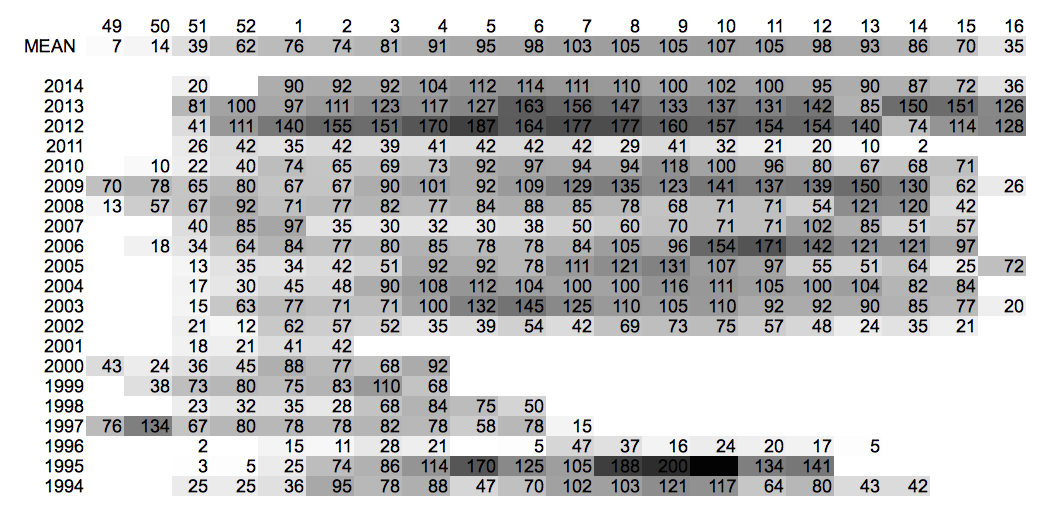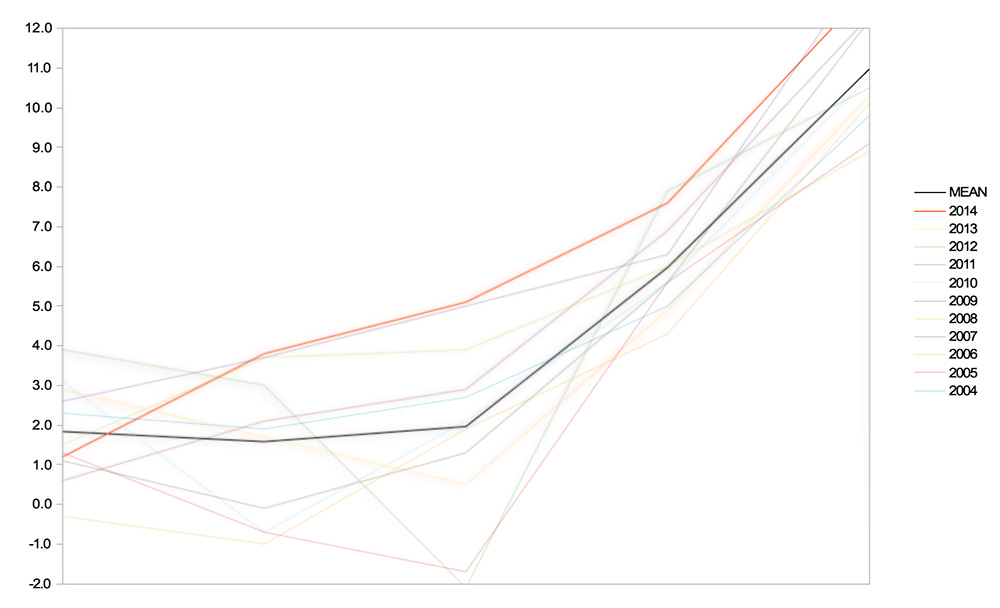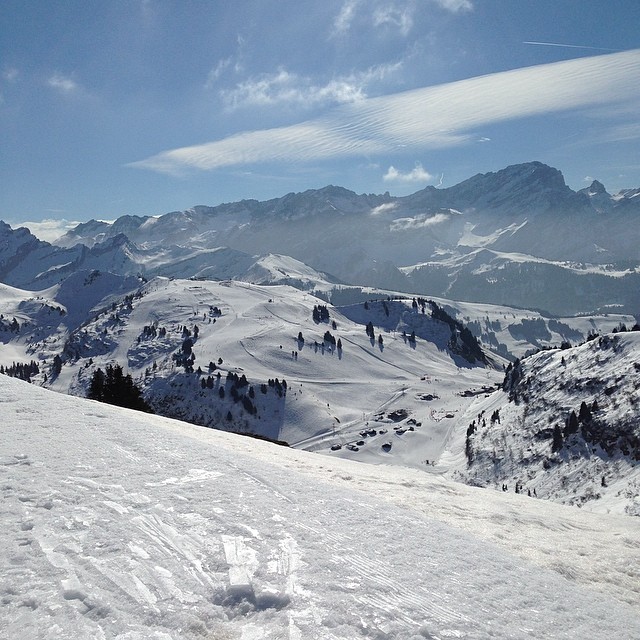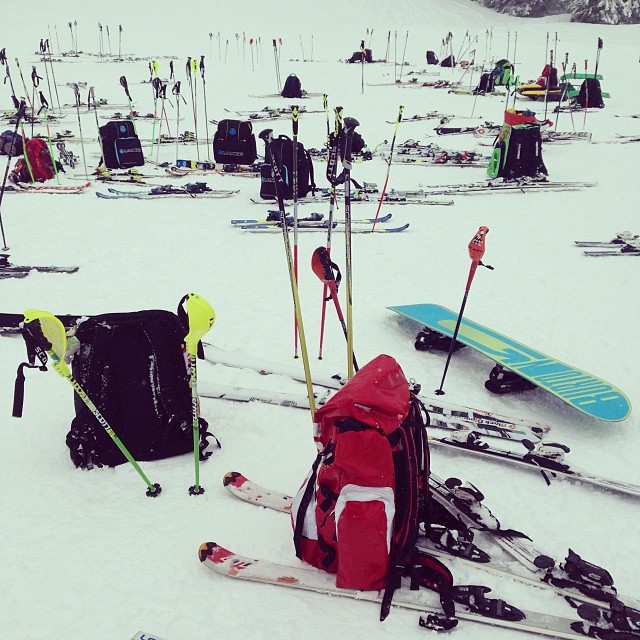The season is over, well almost over as i write this; there has not been snowfall for a month and temperatures have been above 10ºC most days, but remarkably a few pistes are still open near here. Higher resorts will be open until mid May, with some even keeping one or two pistes open year round.
I’ve been told by several people that this season has been pretty poor, which is interesting given that i have spent more than thirty days on the pistes since the start of the year; every weekend and some days in-between and i could have taken more. I had a lot of fun, although there were few powder days.
I guess it’s all relative. Last year was, i’m told, one of the best seasons in twenty years so it’s no wonder this season has been a disappointment in comparison. I wondered if we could quantify that, so being typically English i thought we should start with…
The Weather
The pistes actually opened early this year. We had low temperatures and enough snow in the last weeks of November that allowed Croix des Chaux to open the last weekend of that month. Normally the opening date is scheduled for the last week of December. So it looked promising. But then it didn’t snow at all in December, which would seem bad but the new year saw heavy snowfalls. All lifts and pistes then remained open for the next three months.
So has it been a bad winter? We can probably answer that by looking at historical snowfall data as that is the key indicator of the quality of a ski resort. What follows is a heat map of the last twenty years’ snow reports from Villars1:

Week numbers across the top, main figures are mean snow depth on the pistes in centimetres. Background colours are the darker the deeper. The MEAN row at the top covers only the past ten years. Usual caveats apply - there are gaps in the data between 1996 and 2000. I’m sure some of the reports are incorrect2. I tried to come up with a heat map that eases comparison without getting too in detail on exact figures. A lot of reports i’ve seen on the web have comprehensive data but don’t show that in a way that makes at a glance comparison across years easy.
So from this heat map we can see that this last season has been pretty average in terms of snow depth. What’s more the previous two seasons were exceptional, pushing up the mean values making this season appear not as good as it actually was. So why has this season been thought of as poor? I think the two main factors are the late start, with every season except this one having snowfall in the last two weeks of December, and the aforementioned previous two exceptional seasons still being in memory.
Snowfall data is probably the first thing we look for when evaluating a resort, but we can’t take that in isolation. Temperature plays a key part in the quality of the snow and having a large snowfall but then high temperatures is going to result in a couple of good days but then slush. This is unlikely in the high season, but there were a couple of times when this happened towards the end of the season - one weekend was fantastic with 30cm of fresh powder and low temperatures but the next weekend, after high temperatures, the snow was terrible.
Can we establish if temperatures were higher than usual? Yes3:

Ah, now this is more interesting. The graph shows the last ten years average monthly temperatures in ºC with the months December through to April on the x axis. This last season and the mean are the stronger lines (mean is the black line). Although the season started out with average temperatures, January and February were more than twice the average and the season ended up having the highest temperatures for the past decade.
So it seems this season was fairly average from a snowfall point of view but had significantly higher temperatures. Having the snowfall start late then high temperatures is not what a resort wants, but there was enough snowfall to just about stretch the season out to the full four month schedule. Compare the season to 2011 and 2007 and it doesn’t seem bad at all.
Seventeen Percent
A late start is not what a resort wants because, for those that are low to mid-level in altitude, people are unlikely to book in advance. This is especially the case when there are higher resorts, with guaranteed snowfall, only an extra hour or two away. Even though we had enough snow the late arrival probably put some people off.
There are strong incentives for resort to stay open for the entire season, irrespective of the level of snowfall. Villars features snow generating machines on many pistes, and even those resorts with guaranteed snowfall will use artificial snow to ensure pistes are in excellent condition for when the real snow arrives and to prolong the life of of runs4. Investment in infrastructure also needs to be recouped, larger resorts put significant amounts of money into improvements5.
![]()
It’s not just lifts - the above picture shows a piste-basher (“rat-tracker”) moving snow from off-piste areas ready for replenishing on-piste runs. This image was taken after a couple of weeks with no snowfall and high temperatures. Piste and snow management is a season-round requirement, with several of these machines in operation everyday after the lifts close.
Villars is slightly unusual in that it is a small resort but with infrastructure of a bigger one. This can be explained by the presence of two private schools that bring year round jobs to it rather than just seasonaires. The base population, including surrounding villages, is around 3,500 and this swells to 20,000+ during the high season6. I received a shock on my return after Christmas to see traffic-jams on the roads and queues in the shops. The population swing isn’t unique to Villars, and is not just explained by seasonal second homes, it is common enough to have been the subject of recent initiatives7.
February was the busiest month; arriving at the Roc d’Orsay télécabine for the opening would mean long queues, and by 11am you could be waiting in line for a lift for more than fifteen minutes. The pistes were super busy and you have to be aware of your surroundings and keep your distance. I started the season quite tentatively, unintentionally getting in the way once or twice, so i felt quite slow. By the high season i was at a level where i had to slow down myself to avoid others going somewhat slower than me.
I got through the season without any accidents but others weren’t so lucky. For a couple of weeks in February i heard sirens every day and on the final day of the high season, March 8th, i counted five rescue helicopters.
An Expensive Hobby
It’s common knowledge that skiing and snowboarding are expensive sports, but for most people these go together with a vacation so you can possibly discount the cost of flights and accommodation on the basis that, well, that has to happen anyway. Perhaps we can discount the cost of equipment, because that’s an initial outlay that should last you several years if you’re only spending a couple of weeks a year using it. I’m not so sure though, one observation from my time on the lifts is that a significant number of people rent the equipment.
I already arrived with boots and clothing, which would have cost me in the region of 600 CHF, but i needed a board, bindings, and goggles. I ended up spending 800 CHF for those, but they should last me a few years at least. They do need looking after, i.e. servicing, which again means more costs.

Being resident in Villars means i am eligible for a discounted season lift pass8. This is the price everyone has to pay to use the pistes, except those under nine or over seventy nine years of age. A season lift pass cost me 590 CHF, which is about half the price of standard season lift pass and equivalent to ten single day passes or fifteen days bought in advance.
The advantage of having the season lift pass is being able to use the pistes without the feeling of needing to “get your money’s worth”. Most days i would get the first lift up, when the snow is best, and then finish at lunchtime when it started to get busy. More than thirty days means it worked out at less than 30 CHF a time. A two hour session at an indoor slope in the UK costs approx 50 CHF, so from that perspective it seems to be very good value.
Have Plank Will Travel?
Whichever way you look at it, snowboarding, skiing, whatever, it costs. This is a huge barrier to entry for a lot of people. It was one of the factors that put me off initially. In the fifteen or so years i’ve been skateboarding it had been suggested to me on more than one occasion that i should try snowboarding, but my response was always the same: what’s the point? An activity that, if you can afford it, you will spend at most two weeks a year doing it for real. “For real” in the sense that any other time you do it, again if you can afford it, you will be limited to expensive indoor facilities that aren’t anything like the real thing9.
I was always approaching this from the perspective of a skateboarder, where you are never more than an hours drive from a decent skatepark; or a bus ride from a city centre; or a stone’s throw from some flat ground. And it doesn’t cost anything to roll around on the wheely plank. And you don’t need special equipment, other than the skateboard itself, no warm clothing, boots, or goggles
I wondered how it was possible to become comfortable with snowboarding only having a dozen or so hours of active riding per year. Partly i was remembering the learning curve with skateboarding, where if you skate for an hour or two a few times a week you might be able to pop a little ollie after a few months or a kickflip after six or cruise a bowl effortlessly after maybe three or four years. Then within a decade you will start to feel comfortable, like it’s become a part of you.

But then two years ago it was suggested to me again that i should try snowboarding, and this time i decided i would. I had hit a plateau with skateboarding, something that happens from time to time, and a couple of bad winters meant i had been spending three or four months when i didn’t get more than an hour a week on average to roll around. I picked up snowboarding easily, almost certainly due to the skateboarding as there are enough similarities in the basic movements. In fact, i actually spent the entirety of my introduction day riding switch stance. Only when it came to linking toeside turns did i decide to change to regular stance, which is my skateboarding stance10. After that it was relatively easy.
Having had lots of time on the slopes in my first season has allowed my to play around a bit with my stance and posture. I started the season with a forward stance, binding angles at +30/+6, but gradually moved to a more balanced setup of +18/-9. Oddly enough when i was spending time at the indoor slopes back in the UK i was using +15/-15 and would alternate every two runs between regular and switch stance; but this season i haven’t ridden switch once save for a couple of short runs on the flat, maybe i’ll spend next season riding switch.
I’m not sure what the learning curve is for snowboarding as i’m still only in my second year, and only at the end of my first real season of riding, but there were a few moments towards the end where it started to click. Riding down some of the longer runs at over 60kph and linking turns without having to think about it, feeling alone on the mountain, i could suddenly understand the appeal.
-
Sourced from Snow Forecast. ↩
-
I can’t prove this, but a general rule when dealing with data of significant size or of a significant time range: it will contain crap. ↩
-
Sourced from here - Note that i had to take figures from Aigle as this was the nearest data point to the resort so these figures will be higher than the real values - Aigle is 1000m lower than Villars-sur-Ollon. ↩
-
“Et pour donner un coup de pouce à la nature, il y a les canons à neige … On fabrique de la neige depuis la mi-novembre, histoire d’avoir une bonne couche de fond qui tiendra jusqu’à Pâques” ↩
-
Recent investment in Villars - video and Zermatt. See also “Combien ça côute” in the link in footnote 4 above. ↩
-
http://www.ollon.ch/N389/population-et-altitudes.html. Walk around Villars during the off-season and you will see many an empty chalet. ↩
-
“Ici, personne ne les a jamais vus. Je doute sincèrement qu’ils y vivent six mois par année” ↩
-
Of course these don’t apply if you’re lucky enough to live in or near a real resort, or if you become a seasonaire. But what percentage of people is that? ↩
-
It’s hard to describe how counterintuitive switch stance toeside turns felt to a skateboarder. They’re the oddest feeling. But then, the whole switch/fakie thing works a bit different on a snowboard since your feet are locked in place. ↩